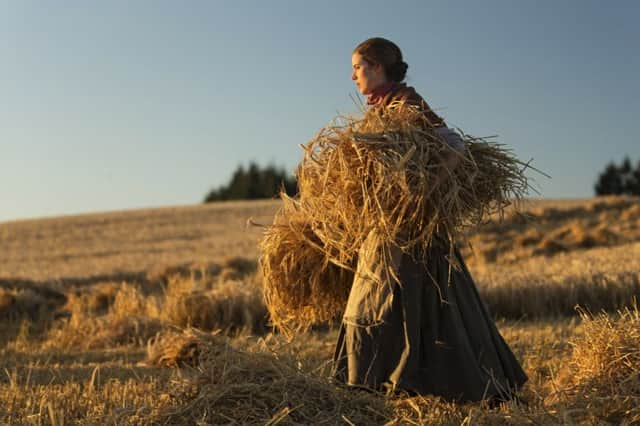From hated book to literary treasure: the story of Sunset Song


The wind blows hard at Bloomfield, the childhood home of Lewis Grassic Gibbon, where he would hide down in his father’s barley field and watch the toughness of farm life buckle and toil around him.
From the croft where his family made a living from two fields, there is a full circle view of this part of the Mearns, where people shrink to tiny figures against the huge skies and never ending land.
Advertisement
Hide AdAdvertisement
Hide AdJames Leslie Mitchell – the birth name of Lewis Grassic Gibbon – stood differently amongst his folk and it was his impressions of life in this corner of the North East that he would forge into Sunset Song, frequently hailed as the greatest Scottish book of all time and now a major film.
But the novel wasn’t well received by some – least of all the residents on which Grassic Gibbon’s caustic character sketches were based.
Isabella Williamson, manager and co-founder of the Lewis Grassic Gibbon Centre in Arbuthnott, said many people were recognised locally within the book; the name changes were not enough to disguise the actions and traits of some.
“It was seen as pornographic. Grassic Gibbon was touching on subjects that people didn’t talk about, that had been going on, for sure, but were just not discussed,” Ms Williamson said.
“There was suicide in there, there was incest, a soldier being shot for desertion. All the types of things you wouldn’t discuss openly.”
Sunset Song was written at a time where Grassic Gibbon found himself far away from Arbuthnott. He went to Aberdeen to work as a reporter before moving to a Glasgow-based farming magazine. In 1919, he was posted overseas after joining the Royal Army Service Corp before relocating to England. The hard labour of the fields stood in sharp relief to the comfortable home in Welwyn Garden City, Hertfordshire, where he and his family remained.
The book outraged a community and divided his family. His father reportedly refused to shake his hand on a visit back hoem after Sunset Song was published.
Set in the shadow of war at a time of deep change to country life, Grassic Gibbon depicted a darkness and oppression, of women of passion and smeddum and men who were weak or depraved.
Advertisement
Hide AdAdvertisement
Hide AdIt was an image that some just did not recognise – and if they did, they certainly would not be speaking about it.
Some people in Arbuthnott and the surrounding villages refused to keep Sunset Song in the house, such was the offence it caused.
It was also banned in many libraries upon its released 80 years ago.
The task of carrying Grassic Gibbon’s legacy in recent years had fallen to Dr Rhea Martin, the daugther of Grassic Gibbon and his wife, Rebecca “Ray” Middleton.
Until Dr Martin’s death last year, she had done much to bring attention to the work of her father – she had also advised director Terence Davies on her father’s life and work.
Her son, Alister Martin, who lives in Welwyn Garden City, visited Arbuthnott earlier this week with his family for a sell-out screening of Sunset Song at Lewis Grassic Gibbon Centre, attended by 170.
“All my children had already seen the film at the glitzy London premier,” he said. “That is of course one particular world and I wanted to bring them to where he was from and see Bloomfield where he lived and the school that he walked to.
“My grandfather always said the ‘land endures’ and my job is to make sure the book endures.
Advertisement
Hide AdAdvertisement
Hide Ad“When he died my grandmother spent the rest of her life to sure he wasn’t forgotten. We wouldn’t be here without her and we have to continue that.”
Martin said he felt a strong connection with the Arbuthnott area, despite “being English and living to the north of London.”
“[Arbuthnott] is a big part of my roots and I do feel this powerful bond,” he said.
Mr Martin and his family visited Bloomfield on the trip, where owners Bill and Dorothy Clark arranged for a plaque to be put up to mark the writer’s childhood home.
They moved to Bloomfield seven years ago and were unaware of the cottage’s past until they found a folder full of cuttings and information about the writer.
The odd person may now stop in the layby to look at the cottage, but there is a feeling more could be done on the writer’s home turf to mark his life.
A map produced by VisitScotland illustrates Sunset Song’s filming locations, which are mainly in Royal Deeside. While the map features Arbuthnott Church and the Grassic Gibbon Centre, it does not feature Bloomfield or the school, where Grassic Gibbon forged his passion for writing.
Williamson at the centre, which operates without any public funding, hopes the film will recharge interest in Grassic Gibbon.
Advertisement
Hide AdAdvertisement
Hide AdShe said: “He is pretty much ignored in some ways. Not many of the schools round here use Sunset Song. I think there may be just one.
“It’s well deserved that a film should be made, it is something we have wanted to see at the centre for a very long time. Our only sadness is that Rhea didn’t get to see it.
“We hope the film will bring a renewed interest in Grassic Gibbon and I hope to a younger generation.
“I don’t remember hearing many of the place names around here in the film. But I suppose if they will Google us, people will just find their own way here.”